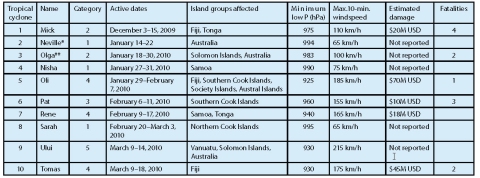Tropical Cyclone summary – 2009/10 season
During the 2009/10 Tropical Cyclone (TC) season, normal activity was forecast for most countries in the southwest Pacific. Two climate forecasts were made for the southwest Pacific by NIWA in conjuction with the Pacific Islands Meteorological Services; one preceding the start of the TC season (released in mid-October 2009) and an updated forecast for the late part of the season covering February – April 2010 was released in mid-February.
The overall TC activity was expected to be near normal, with 8 – 11 storms forecast for the 2009/10 season. Two or three storms were forecast to reach at least Category 3, and one storm was expected to reach at least Category 4, with mean wind speeds of at least 64 knots or 118 km/h.
Documentation of the TC activity during the 2009/10 season has been coalated from reports issued by the Regional Specialised Meteorological Centre in Nadi, Fiji, the Joint Typhoon Warning Centre at Pearl Harbour, Hawaii, the Tropical Cyclone Warning Centre based at the New Zealand Meteorological Service in Wellington, and the Australia Bureau of Meteorology, and are tabluated below.
In the Southwest Pacific sector covered by the ICU forecast, 10 TCs were documented for the 2009/10 season. The onset of the season did not occur until early December 2009. All of the storms that occurred during the first two months of the season (about half of the total for 2009/10) achieved only a Category 1 or 2 status. In contrast, the back half of the TC season saw the development of four systems that reached or exceeded a Category 3 status. Two Category 4 storms had winds in excess of 160km/h (Oli and Rene), and one event had 10-minute sustained winds in excess of 200km/h (Ului).
The minimum estimated damage for the 2009/10 season was $163M USD, and there were 12 fatalities reported for the region as a result of TC activity.

Tropical Cyclone summary – 2009/10 season
